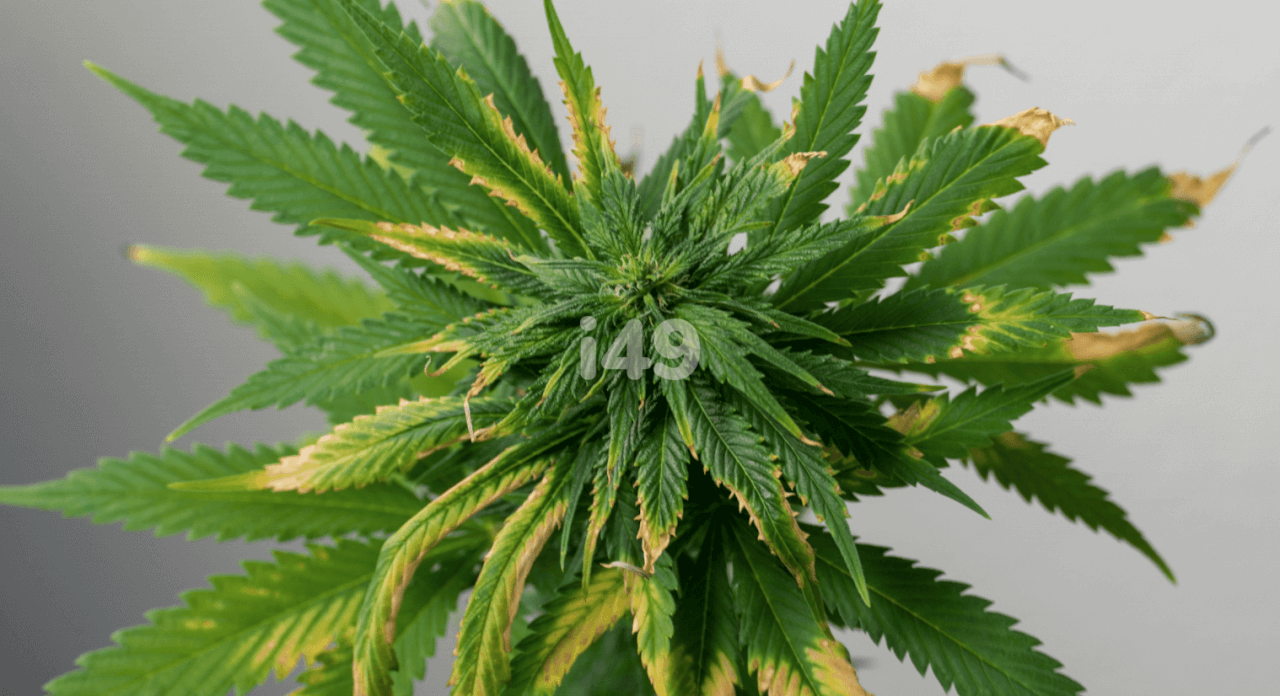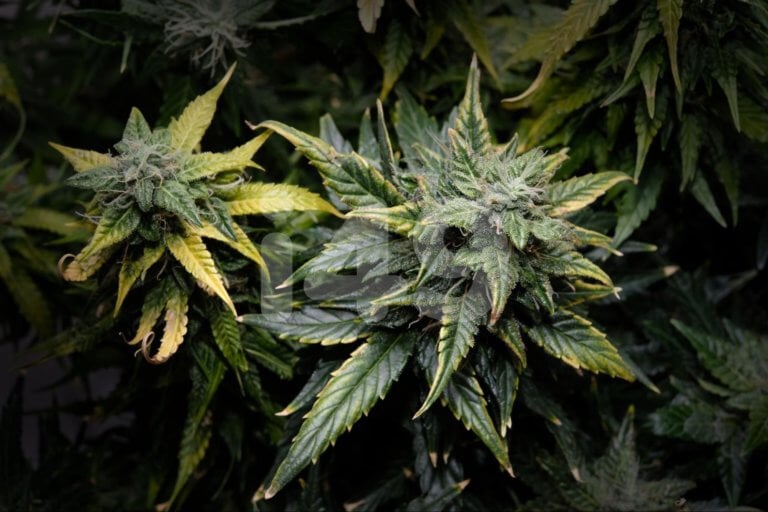Are you seeing burnt leaves, strangely twisted growth, and tiny, dry buds? You might be dealing with a potassium deficiency in weed.
Potassium is an essential macronutrient for plants in all life stages, especially flowering. When it’s in shortage, marijuana displays clear and alarming signs of distress, which might culminate in crop death. How do you notice, prevent, and treat this issue?
Keep reading for a complete guide on potassium shortages in weed plants. We discuss the causes, symptoms, solutions, and safeguards. In the spirit of exhaustiveness, we also touch on potassium burn in cannabis.
Let’s get to it!
What does cannabis use potassium for?
Potassium (K) is a silvery metal found in various minerals and foodstuffs. It supports healthy tissue development in the human body and is equally vital for plants.
Crops require nutrient supplements while growing from weed seeds. Cultivators mainly focus on macronutrients under the NPK acronym. Nitrogen, phosphorus, and potassium are necessary in large quantities and support the transition of a tiny seedling into a large, bud-laden lady.
What’s the role of potassium in particular?
This mineral supports protein synthesis, chlorophyll production, photosynthesis, and carbohydrate absorption. In vegging, it aids crop growth and structural integrity. Plants use potassium at the end of the flowering period to process nutrients and get nugs sticky.
The leaves contain the highest concentrations of this element, so they’re the first to show signs of a shortage. Long-term scarcities damage the colas, branches, and stems.

This cultivation pitfall is the most common in low-mineral environments like depleted soils and over-treated water. Even growers with rich lands using high-quality fertilizers aren’t entirely safe from the deficiency, and here’s why.
The reasons for a cannabis potassium deficiency
The causes of a potassium deficiency in weed plants include a lack or excess of minerals, overwatering, and pH variation.
Most modern fertilizers contain ample NPK, accommodating crops’ needs in each life stage. Other minerals might be lacking, though.
Like a nitrogen deficiency, a potassium shortage might be due to a scarcity of macronutrients. Notably, when there’s a lack of calcium and magnesium, roots become incapable of processing other minerals.
The opposite extreme causes similar problems. An overabundance of mineral salts can lock out fresh food. Interestingly, an excessive amount of potassium blocks itself, so your substrate ends up teeming with inaccessible K.
We also can’t disregard soil chemistry. The acidity or alkalinity of your growing medium affects mineral absorption rates. Even if there’s plenty of food surrounding the roots, plants can’t consume it at an inappropriate pH.
Potassium is best-absorbed at higher pH values. It gets locked out when pH is under 6.0 in soil and 5.5 in hydroponics.
Overwatering and poor aeration leave the soil muddy and clogged; long-term exposure to such substrates harms the roots. A potassium deficiency in marijuana directly follows the damage.
Note: Other gardening errors, like light burn and plant stress, can also damage potassium absorption rates. Addressing the primary issue clears the sign of deficiency.
Symptoms of a potassium deficiency in weed plants
Many weed nutrient deficiencies have similar symptoms. Since minerals are necessary for optimal plant functioning and development, shortages manifest as ill health throughout the crop.

Potassium is an essential nutrient, and a lack of it shows. Warning signs generally start with leaf discoloration and progress to stunted growth.
For quick reference, here’s a cannabis potassium deficiency chart for each stage:
- Early stage: Burnt leaf tips and edges on older foliage.
- Middle stage: Yellow blades, slower leaf production.
- Late stage: Dying foliage, stretching stem, stunted bud growth.
The lack of potassium in leaves
A potassium deficiency in a weed plant first appears on the lower and middle leaves.

The blades turn yellow at the tips, and discoloration gradually advances towards the base. This effect resembles a nutrient burn. The leaves grow pale, dead tissue spots appear, and the foliage wrinkles and dies with time.


A potassium shortage might also affect the stem. Red, gray, and brown spots may appear near the affected branch and ‘climb’ upward, though this symptom is less common.
The lack of potassium in shoots
Potassium is a mobile nutrient that travels along the stem. As a result, a shortage first appears in old growth. When left untreated, it also affects upper leaves and shoots.

New growth appears smaller, weaker, and slower to sprout in a weed plant with a potassium deficiency. If enough time passes, your crop might appear thinner on top than at the bottom.
How does it affect cannabis buds?
When it appears in the blooming stage, a potassium deficiency in cannabis affects the buds. It delays bloom formation and decreases cola size, density, and weight. Crops may finish ripening but produce tiny yields of skinny flowers lacking cannabinoids and terpenes.

Potassium deficiency vs. light burn
Potassium shortages appear as paling and yellowing at the leaf tips. This symptom strongly resembles a light burn. Curling and clawing leaves in later stages are typical in both issues.
Light burn occurs due to lamps sitting too close to your crops. The rays’ intensity might burn and bleach the canopy even with cool LED globes.
Check the following to differentiate between the two problems:
- Lamp distance: If your fixtures are much closer to the canopy than the manufacturer’s suggestion, it’s likely a light burn.
- Symptom location: Potassium scarcity usually starts at the base, while light burn manifests across areas the closest to the lamps.

If dealing with a burn, learn how much light a weed plant needs and adjust your equipment accordingly.
Otherwise, let’s see how to fix potassium deficiency in weed plants.
Fixing a potassium deficiency in weed plants
When growers notice any mineral shortage, their first instinct is to provide more nutrients as soon as possible. Although it makes sense, this approach might only lead to toxic soil and a waste of valuable fertilizer.
First, compare the symptoms and causes we’ve described with what you’re seeing in your garden. Should you diagnose a cannabis potassium deficiency, here are the steps to resolve it.
Flush and adjust the substrate
If excess nutrients or an imbalanced pH cause a marijuana potassium deficiency, clean your substrate to aid absorption. To do this, flush the soil or hydro tank before adding more nutrients.
Cannabis can only absorb minerals in slightly acidic environments. Flushing restores the pH balance and provides a clean slate for tweaking nutrients.
Here’s how to reset the substrate:
- Get four times the container size of pH-neutral water. So, 16 gallons for a 4-gallon pot.
- Slowly pour the liquid around your plant. Let excess moisture drain from the bottom.
- Leave the soil to dry in a breezy spot before providing additional food and H20.
If using a hydroponic setup, empty and wipe the container before filling it with pH-neutral water. Let this liquid circulate for 24 hours before treating it with nutrients.
Once the soil is at the perfect pH level, provide additional minerals. Choose the best fertilizers for weed in vegetative and flowering stages and follow the manufacturer’s instructions on dosage and application frequency.
Prevent future imbalances with regular checkups. During every feed, measure the pH of the H20, water-soluble fertilizer, and runoff liquid to determine whether any element is too alkaline. Use a pH-Up or pH-Down solution to maintain optimal acidity.
Add extra potassium
A potassium deficiency during flowering might leave you with skinny colas. It’s best to supplement this mineral to encourage prolific growth.
Organic solutions are your friends and supply the necessary elements without oversaturating the soil. The following are good sources of nutrients with an emphasis on potassium:
- Banana peel tea: Soak the peels of ripe bananas in H20 for two days before watering. Avoid boiling the solution as heat neutralizes nutrients, making this blend less effective.
- Wood ashes: This nutrient might increase salt levels, so use it sparingly and in small quantities. Sprinkle a handful of powder onto the soil before soaking the substrate with water for a long-term source of K.
- Bone meal: This fertilizer supplies high amounts of potassium, calcium, magnesium, and phosphorus. It may raise pH, so apply it in moderation and track acidity levels.
- Seaweed: Mix this powder or gel into your liquid fertilizer and water as usual. Seaweed ramps up soil health and supplies beneficial micronutrients.
Applying these minerals once is enough for all but severely deficient crops. They gradually feed the soil, providing a healthy potassium dose while your fertilizer re-establishes nutrient harmony.
Practice good gardening
Even when following these solutions, a potassium deficiency in cannabis plants leaves them susceptible to stress and disease. After resolving the primary issue, pay extra attention to your gardening conditions to help restore crop health.
Learn how to water cannabis to avoid accidentally flushing the soil with excessive H20. Proper amounts of moisture ensure root zone health and prosperity.
Skip training to let plants recover and maintain optimal temperature and humidity levels. Marijuana is sturdy and recuperates quickly, but it needs a helping hand.
Pro tip: Healthy new growth means the potassium deficiency in your cannabis plants has cleared, but the dead blades won’t become green again. Remove the damaged foliage, as it might become a breeding ground for pathogens.
Potassium burn on cannabis plants
You now know how a shortage of this mineral looks and how to solve the issue. What if you’re dealing with a potassium excess in cannabis, though?
Cannabis nutrient burn occurs when there’s a surplus of minerals in the substrate. It manifests in the leaves, stems, and buds and hinders development. In the case of potassium, common symptoms include:
- Thin blades on top leaves
- Burnt leaf tips and edges
- Brown spots on lower leaves
- Curling and wilting foliage
- Low pH at the root zone
These symptoms resemble a deficiency, so check your garden to differentiate between them. Unhealthy roots and improper pH levels cause scarcities. Potassium toxicity in cannabis is more likely in clay soils and follows overgenerous bloom feeding.
If you diagnose a potassium burn, flush the soil to eliminate the extra minerals. Amend future fertilizer dosages per the manufacturer’s instructions.
Ample potassium for healthy pot
A potassium deficiency in weed can have disastrous consequences, but being proactive can resolve the issue and salvage your harvest. Prevention is better than cure, so keep the environmental factors behind this problem in mind and fight them from day one.
Use quality fertilizers to supply your crops with all macronutrients. Regularly test and adjust pH levels and watch for excess salts in the soil. Follow these practices for a healthy and happy garden.
If you’re new to cultivation, head to our shop to choose a resilient strain from our comprehensive selection. Buy seeds and learn the weed feeding ropes on a hardy specimen.












